I'm designing a Slide Navigation Panel due to that tutorial.
Everything works fine. Now I want to go further and work on some UX issues. This is how my app look like now. But still I can manipulate MapView. My goal is to do two things:
1) Prevent all interaction with MapView, such as scaling and moving
2) Close navigation panel, while tapping on viewController with map.
The main file for controlling this two controlller is containerViewController. Here is the source code for it:
import UIKit
import QuartzCore
enum SlideOutState {
case BothCollapsed
case LeftPanelExpanded
}
class ContainerViewController: UIViewController {
var centerNavigationController: UINavigationController!
var centerViewController: ViewController!
var currentState: SlideOutState = .BothCollapsed {
didSet {
let shouldShowShadow = currentState != .BothCollapsed
showShadowForCenterViewController(shouldShowShadow)
}
}
var leftViewController: SidePanelViewController?
override func viewDidLoad() {
super.viewDidLoad()
centerViewController = UIStoryboard.centerViewController()
centerViewController.delegate = self
// wrap the centerViewController in a navigation controller, so we can push views to it
// and display bar button items in the navigation bar
centerNavigationController = UINavigationController(rootViewController: centerViewController)
view.addSubview(centerNavigationController.view)
addChildViewController(centerNavigationController)
centerNavigationController.didMoveToParentViewController(self)
}
}
let centerPanelExpandedOffset: CGFloat = 60
extension ContainerViewController: CenterViewControllerDelegate {
func toggleLeftPanel() {
let notAlreadyExpanded = (currentState != .LeftPanelExpanded)
if notAlreadyExpanded {
addLeftPanelViewController()
}
animateLeftPanel(shouldExpand: notAlreadyExpanded)
}
func addLeftPanelViewController() {
if (leftViewController == nil) {
leftViewController = UIStoryboard.leftViewController()
leftViewController!.categories = Category.allCats()
addChildSidePanelController(leftViewController!)
}
}
func addChildSidePanelController(sidePanelController: SidePanelViewController) {
view.insertSubview(sidePanelController.view, atIndex: 0)
addChildViewController(sidePanelController)
sidePanelController.didMoveToParentViewController(self)
}
func animateLeftPanel(shouldExpand shouldExpand: Bool) {
if (shouldExpand) {
currentState = .LeftPanelExpanded
animateCenterPanelXPosition(targetPosition: CGRectGetWidth(centerNavigationController.view.frame) - centerPanelExpandedOffset)
} else {
animateCenterPanelXPosition(targetPosition: 0) { finished in
self.currentState = .BothCollapsed
self.leftViewController!.view.removeFromSuperview()
self.leftViewController = nil;
}
}
}
func animateCenterPanelXPosition(targetPosition targetPosition: CGFloat, completion: ((Bool) -> Void)! = nil) {
UIView.animateWithDuration(0.5, delay: 0, usingSpringWithDamping: 0.8, initialSpringVelocity: 0, options: .CurveEaseInOut, animations: {
self.centerNavigationController.view.frame.origin.x = targetPosition
}, completion: completion)
}
func showShadowForCenterViewController(shouldShowShadow: Bool) {
if (shouldShowShadow) {
centerNavigationController.view.layer.shadowOpacity = 0.8
} else {
centerNavigationController.view.layer.shadowOpacity = 0.0
}
}
}
private extension UIStoryboard {
class func mainStoryboard() -> UIStoryboard { return UIStoryboard(name: "Main", bundle: NSBundle.mainBundle()) }
class func leftViewController() -> SidePanelViewController? {
return mainStoryboard().instantiateViewControllerWithIdentifier("LeftViewController") as? SidePanelViewController
}
class func centerViewController() -> ViewController? {
return mainStoryboard().instantiateViewControllerWithIdentifier("CenterViewController") as? ViewController
}
}
My idea is to create variable that stands for active side panel and write a function, that will solve my issues:
I see something like that:
func blockCenterView() {
let AlreadyExpanded = (currentState = .LeftPanelExpanded)
if AlreadyExpanded {
//no idea what to write here
}
}
Am I right, or there exist other variants for solving that problem?


